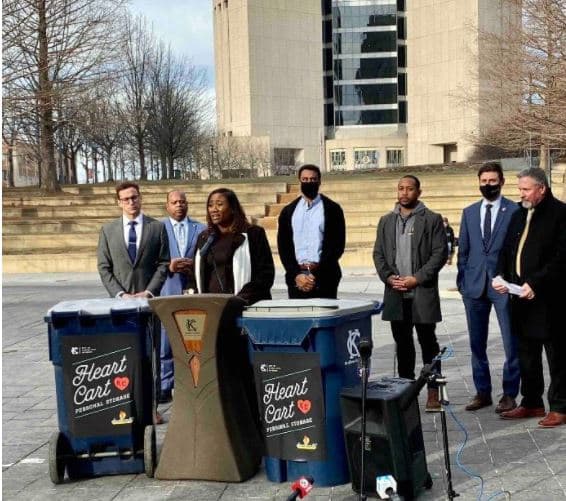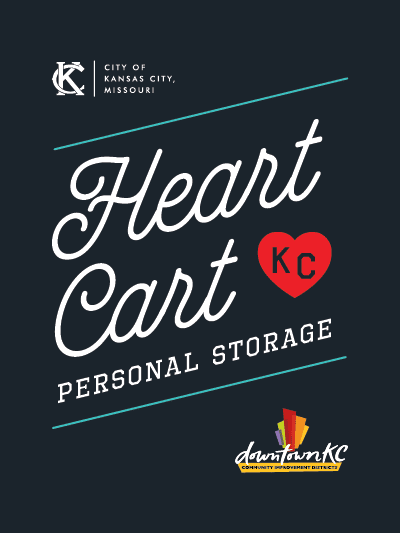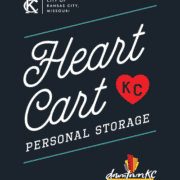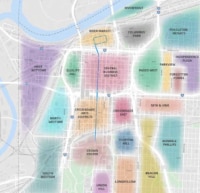City & Downtown Council deliver Heart Carts for winter relief

Brian Platt, City Manager; Michael Shaw, Director of Public Works; Ryana Parks-Shaw, 5th District Councilwoman; Zachary Bird; Wallace James, Community Improvement Districts; Eric Bunch, 4th District Councilman; and Sean O’Byrne, Downtown Council; celebrate the debut of the Heart Cart storage containers for the unhoused population.
City & DTC team up to provide storage containers for the unhoused
The City of Kansas City is partnering with the Downtown Council to make sure unhoused residents have safe, warm shelter during extreme weather events not only for themselves, but also their belongings. The new “Heart Carts” were introduced Wednesday afternoon during a news conference at Ilus Davis Park, across from City Hall.
“We have been listening to the community, and seeking innovative ways to help those in need,” said Fifth District City Councilwoman Ryana Parks-Shaw, who chairs the Mayor’s Houseless Task Force. “The Heart Cart symbolizes our concern, while solving a problem in a very practical way.”

The City is providing 70 personal storage carts for people to use and the Downtown Council is providing a secure facility for cart storage. This resource is part of the city’s Extreme Weather Activation Plan.
The hope is that more people will be inclined to seek shelter during extreme weather if they know that their personal belongings will be protected.
“The Downtown Council and our Human Service Provider Partners have been involved with providing solutions for our homeless community for over 13 years,” said Sean O’Byrne, vice president of the DTC. “This storage idea and facility is one more dignified way to approach the issue of homelessness and provide the ability to reach basic services.”
“This is a great way to give people experiencing homelessness peace of mind and a dignified way to store their possessions,” said Wallace James, Human Services Coordinator for the Community Improvement Districts. “Imagine how difficult it would be to go to your doctor’s appointment or go to the DMV with all of your belongings. This much needed storage option removes a challenging barrier when trying to help individuals get housed.”
This pilot program is one of many solutions the City is working on to address housing insecurity, affordable housing and issues facing our houseless community.
The City’s long-term focus is to create more permanent supportive housing and to provide a better response with more resources to those in need. This includes:
- Allocating $12.5 million to the City’s affordable housing trust fund that will incentivize the creation of affordable housing units and other housing options within larger otherwise market-rate multifamily development projects
- Distributing about $16 million in emergency rental assistance funds to nearly 4,000 households in Kansas City
- Using community input to develop a “Vision for Housing” that outlines the plan to create 10,000 new affordable housing units by 2027
- Establishing a Housing and Community Development Department with the City’s first employees dedicated to homelessness prevention and support, tenant advocacy, and affordable housing creation and preservation
- Converting nearly 3,000 vacant lots and homes owned by the City’s Land Bank into affordable housing
- Creating a position in the H&CD Department for a homelessness prevention coordinator
- Turning two former hotels into permanent supportive housing and emergency transitional housing for those experiencing homelessness (The first project has been approved by the City Council, the other is in development.)
- Constructing affordable housing on city-owned property in creative ways, such as the plan to incorporate affordable housing units into the reconstruction of the Barney Allis Parking Plaza
- Finalizing a city policy detailing processes which will help unhoused persons relocate from encampments to safe facilities with supportive services
- Enacting an extreme weather plan that activates when the daytime high is below 32 degrees, or the overnight low is less than 20 degrees
—


